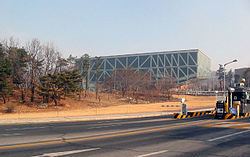Country South Korea Postal code 08700 ~ 08899 Population 520,849 (2010) | Region Sudogwon Administrative dong 21 Area 29.57 km² Local time Sunday 6:11 PM | |
 | ||
Time zone Korea Standard Time (UTC+9) Weather 9°C, Wind W at 10 km/h, 63% Humidity Points of interest | ||
Gwanak District (Gwanak-gu) is an administrative subdivision (gu) of Seoul, South Korea. It lies on the southern skirt of Seoul, bordering Anyang of Gyeonggi Province. The southern border of Gwanak-gu, bordering Anyang, consists of the craggy ridgeline of Gwanaksan (Mt. Gwanak), which dominates the local geography.
Contents
- Map of Gwanak gu Seoul South Korea
- Overview
- Commercial zones
- Transportation
- Public transportation
- Metro stations
- Administrative divisions
- Points of interest
- Sister cities
- References
Map of Gwanak-gu, Seoul, South Korea
Originally a part of Siheung, Gyeonggi, it was transferred to Seoul with the rapid expansion of the National Capital Area and its population growth in 1960s. Partitioned from Yeongdeungpo District and established as a district in 1973, it now neighbours the Seocho, Dongjak, Guro and Geumcheon Districts, and exercises jurisdiction over 21 neighbourhoods (dong), with a population of 500,000.
Overview
Gwanak District is densely populated with over 500,000 people. While it was once a rural area dominated by the presence of Gwanaksan (Mt. Gwanak), population booms in the late 1950s and early 1960s, accompanied by rapid industrialization of the capital area, quickly changed the town into a mosaic of dense residential and industrial areas. Large slum quarters were formed by migrant populations from all over Korea who sought jobs in industrialized Seoul. A series of redevelopment projects from 1970's, and the relocation of Seoul National University to the district, led to a reduction of slum quarters and indigent textile industries and transformed the town into a residential uptown neighborhood of Seoul. The area is also heavily populated by university students from surrounding provinces.
Commercial zones
Central commercial zones include the Seorim and Daehak area and the Cheongnyong area near Seoul National University. These areas also form a large zone of private dormitories and small houses, which primarily target university students and national examination takers (gosi-saeng) looking for an environment that is favorable for studying. Restaurants, supermarkets, bars and pubs in the area are centered in Nokdu Street (Nokdu-geori) in the Daehak area and near Seoul National University Station. Other commercial zones for residents are located along the Nambu Beltway and two main roads.
The main shopping district, the Bongcheon Central Market (Bongcheon-jungang-sijang), is positioned in Jungang Neighbourhood, north from Seoul National University Station.
Transportation
Nambu Beltway, which circles Seoul, passes through the very center of the district. The beltway and two main avenues, Gwanak Road (Gwanak-ro) and Sillim Road (Sillim-ro), make the main route of the automobile traffic. Nambu Beltway is connected to multiple express ways.
Public transportation
Green Line (Line 2) and Blue Line (Line 4) of Seoul Metro links Gwanak District and other areas. Many trunk (painted in blue) buses such as 501, 506, 651 and 750 lines, and branch (in green) buses in 5XXX or X5XX line passes Gwanak area.
Metro stations
Administrative divisions
There are three statutory subdivisions: Sillim, Bongcheon and Namhyeon Neighbourhood. Those are further divided into multiple administrative neighbourhoods (dong) to balance excessive populations and for administrative expedience. As of September, 2008, there are 21 administrative neighbourhoods in Gwanak District.
